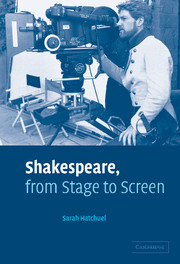Book contents
- Frontmatter
- Contents
- Acknowledgments
- 1 Shakespeare, from stage to screen: a historical and aesthetic approach
- 2 From theatre showing to cinema telling
- 3 Masking film construction: towards a ‘real’ world
- 4 Reflexive constructions: from meta-theatre to meta-cinema?
- 5 Screenplay, narration and subtext: the example of Hamlet
- 6 Case studies
- Bibliography
- Index
5 - Screenplay, narration and subtext: the example of Hamlet
Published online by Cambridge University Press: 22 September 2009
- Frontmatter
- Contents
- Acknowledgments
- 1 Shakespeare, from stage to screen: a historical and aesthetic approach
- 2 From theatre showing to cinema telling
- 3 Masking film construction: towards a ‘real’ world
- 4 Reflexive constructions: from meta-theatre to meta-cinema?
- 5 Screenplay, narration and subtext: the example of Hamlet
- 6 Case studies
- Bibliography
- Index
Summary
In 1997, Kenneth Branagh was nominated for the Academy Award® for the Best Screenplay Based on Material from Another Medium for his 1996 adaptation of Hamlet. It immediately spurred a debate. Since Branagh used every word of the conflated Shakespeare text, how could his screenwriting work be worthy of such an award? This chapter argues that writing a screenplay for a filmed Shakespeare play involves a complex narrative instigation. The dramatic text becomes coated with a subtext that appropriates quasi-novelistic aspects, alternating between dialogues, narrator interventions and focused narrative. Shakespeare dialogues and monologues become the framework of a written narrative that describes, comments, offers an interpretation or creates interpolations. The screenplay represents an intermediary step between the initial dramatic text and the film itself.
In the case of a theatrical production, the textual additions can be implicit when the choices have not been recorded in a written form, or made explicit if the director records notes in a promptbook. In the case of a Shakespeare film, the decisions in terms of mise-en-scène are often made explicit in the published screenplay that accompanies the release of the movie. Regarding the film Richard III in which he played the title role, Ian McKellen says: ‘We were not making a film of the play, we were making a film of a screenplay from the play.’ He thus emphasizes the fact that a film is less faithful to the Shakespeare text than to a first reading of that text.
Information
- Type
- Chapter
- Information
- Shakespeare, from Stage to Screen , pp. 127 - 151Publisher: Cambridge University PressPrint publication year: 2004
